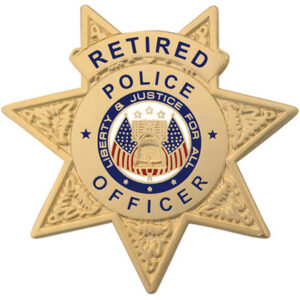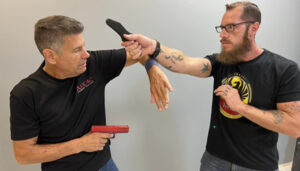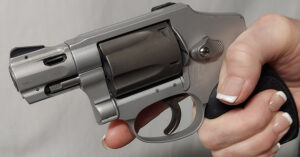As more officers carry pistol mounted optics, adaptations in training should be considered. For example; slide manipulation. The slide must be manipulated during loading the pistol, unloading the pistol, reloads, and malfunctions. The biggest area to train is the emergency reload and clearing a malfunctions. Being able to get a weapon back up and running after slide lock or any type of stoppage, is a very important lifesaving skill that must be trained to become second nature. As a longtime firearms instructor I believe training is essential to finding your method and becoming efficient with any method. It has been said many times that we will not rise to the occasion, but we will fall to our level of training. As firearm instructors it is our duty to ensure that we and our officers are trained and ready in every aspect of utilizing a weapon in a deadly force encounter.
Although the techniques of performing these types of weapon manipulations are essentially the same with or without an optic, there are a few things to consider when placing an optic on the slide. The optic may get in the way or hinder the technique you’re currently use, however it might create other methods that are just as effective. I am going to cover several ways that I teach my officers to perform an emergency reload and how to manipulate the side during the procedure, as well as performing a basic malfunction drill and clearing the weapon and getting it back up and running. There are many ways that are being taught and used by officers, and most of them are very effective. What I am going to talk about is “A Way”, not absolutely the way to perform these tasks. There are other ways that are safe and effective and as long as we train with any of the ways we are using and become proficient in them, we are increasing our ability to win a deadly force encounter.
I know people use different terms and language in training. To be clear, when I talk about an emergency reload, I am talking about firing the last round from my magazine and the slide locks to the rear, in most cases. A tactical reload or reload with retention is different due to the fact that I do not need to manipulate the slide. This reload is done preferably when I have time, opportunity, cover, or distance.
In an emergency reload when the slide locks to the rear or you realize your weapon is empty. In an emergency reload, my weapon is out of ammunition, and I need to get it back up as fast as possible. Here I press the magazine release and drop the magazine. Let the magazine fall from the pistol and let gravity work. If you start to bring the pistol up before the magazine drops it may not clear the magazine well and force you to reach up and pull the magazine out. I strongly discourage folks from catching the magazine and trying to stow it during training. I catch officers doing this and saying they do not want to damage the magazine. The overarching problem is we fight like we train. If we allow bad habits in training, we allow trainees to develop training scars and bad habits under our supervision. Once the magazine is dropped, bring the pistol up to what I call your workstation. Muzzle pointing straight up in your strong hand out in front and to the side of your strong side. The weapon should not block your ability to see down range, but you should be able to see your pistol and magazine well in your peripheral vision. This helps in being able to find and smoothly insert your magazine into the magazine well. As you bring your pistol to your work station, your support hand should be retrieving a full magazine from the magazine pouch and being brought up to your pistol to load into the pistol. Once the magazine is fully inserted into the pistol it is time to manipulate the side and complete the reload. From here there are several ways to manipulate the slide to send it forward and load the pistol. I will talk about each of these methods individually and the pros and cons that I have found to each method.

Over the top: I have taught and prefer this method without an optic. It is a strong and effective method by bringing my support hand over the top and grabbing the back of the slide over the rear sight, so you don’t cover the ejection port. Here the operator is able to get a good strong grip on the slide. As you pull back on the slide push forward hard with the pistol, forcing the slide from your support hand. By using this method, it will keep you from ridding the slide closed and causing a malfunction. You can still come over the top with the optic on your slide. You must come over the top of the optic and grasp the optic. If you grasp it in front of the optic, you will cover the ejection port with your hand causing a malfunction.

Using the meaty portion of your support hand: This method works well for me with an optic. Bring your support hand up with your thumb pointing towards the sky and catching the optic with the meaty portion of your palm. You must continue to bring your hand back past the optic at the end and not allow your hand to ride the slide back forward. When the slide moves back to its furthest point your hand should pass over the optic and release the side to go forward.

Using the blade of your hand: with this method you bring your support hand up with your thumb pointing into your body and allowing the blade of your hand and first finger to catch the optic. The biggest issue with this method is that your support hand is covering the ejection port of the pistol and could cause a malfunction. You may also have a tendency to ride the slide forward instead of allowing your hand to move past the slide and clearing the slide to move forward.

Bow and arrow technique: With this method you grab the back of the slide with your thumb and first finger and pull back on the slide and release the slide to go forward. I believe this is a weaker option than going over the top or using the meaty portion of the palm. You may also have a tendency to ride the slide forward instead of pushing it from your grip.

Using the slide release: Many officers use the slide release to send the slide forward. There are arguments about whether this is a fine motor skill vs. a gross motor skill. I still believe it is a fine motor skill and believe under stress and sweat and blood this method may not be as reliable as some of the others. However, officers that train often with this method are fast and able to perform this method with a great deal of success in training.
When it comes to any malfunction clearing technique, I believe the methods to send the slide home are essentially the same and you will use the method that you ingrained through training. After a failure to fire you tap and rack utilizing your preferred method to rack the slide. I believe you will find your preferred method of working the slide to clear the weapon or other types of malfunctions.
I believe that reloads and malfunction drills and weapon manipulation techniques should be a very important part of our training and these techniques should be second nature to our officers. Take advantage of instructor development opportunities whenever you can. The International Association of Law Enforcement Firearms Instructors has been training trainers since 1981 and is one of the finest in the world for cutting edge information and training. (https://www.ialefi.com/training-course-calendar/annual-training-conference/)
Hope to see you there…God Bless and Stay Safe!!!
Sgt. Mitch Woodard
Range Master
Amarillo Police Department
robert.woodard@amarillo.gov




